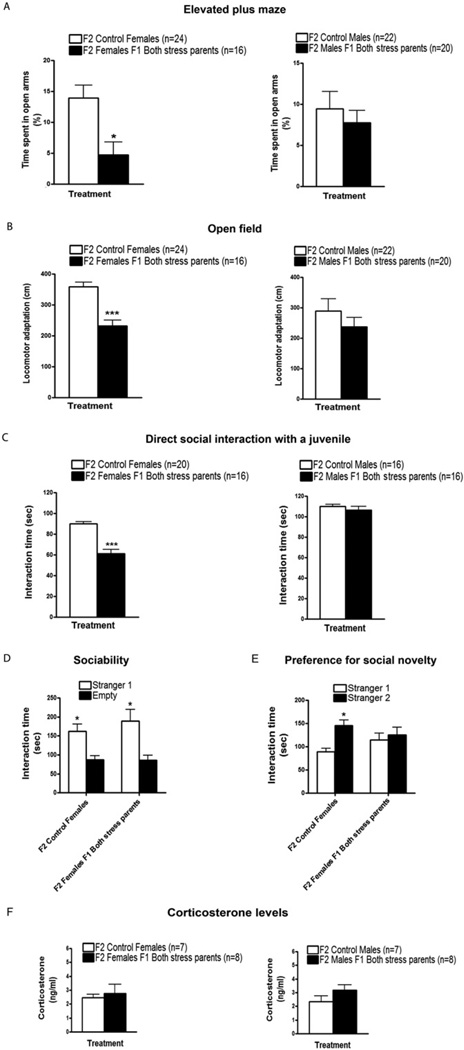Figure 5.
Transmission of enhanced anxiety and defective social interactions to F2 female offspring. F1 females and males from both stressed parents were mated with others F1 mice from stressed parents and their offspring were tested when they were two months old. F2 offspring from control mice were also generated. (A) In the elevated plus maze, F2 females from both F1 mice from stressed parents spent significantly less time in the open arms in comparison with F2 females from control mice [t(12) = 2.839, p < .05; left panel]. F2 males from both F1 mice from stressed parents did not show significant differences in comparison with F2 control males in terms of time spent in the open arms [t(14) < .6636, p > .05; right panel]. (B) In the open field, F2 females from both F1 mice from stressed parents showed a significant reduction in locomotor adaptation in comparison with F2 control females [t(12) = 5.232, p < .001; left panel]. F2 males from both F1 mice from stressed parents showed similar levels of locomotor adaptation as F2 control males [t(14) = 1.053, p > .05; right panel]. Number of litters used in A and B: 5 litters from both F1 parents from stressed mice, and 9–11 litters from both F1 control mice. (C) In the direct social interaction test with a juvenile, F2 females from both F1 mice from stressed parents spent significantly less time interacting with and investigating the juvenile in contrast to F2 control females [t(10) = 7.353, p < .001; left panel]. F2 males from both F1 mice from stressed parents displayed similar interaction levels with the juvenile as F2 control males [t(6) = .8753, p > .05; right panel]. Number of litters used in C: 4–5 litters from both F1 parents from stressed mice, and 4–7 litters from both F1 control mice. (D) In the sociability test, F2 control females (n = 6) and F2 females from both F1 mice from stressed parents (n = 6) spent significantly more time sniffing and interacting with the cage containing Stranger 1 than with the empty cage [F(1,8) = 22.30, p < .05]. (E) In the preference for social novelty test, F2 control females (n = 6) spent significantly more time interacting with and sniffing the cage containing Stranger 2 compared with the cage containing Stranger 1 [F(1,8) = 7.084, p < .05]. In contrast, F2 females from both F1 mice from stressed parents (n = 6) did not show any difference in time spent interacting with both enclosed strangers (p > .05). Number of litters used in D and E: 3 litters from both F1 parents from stressed mice, and 3–4 litters from both F1 control mice. (F) Basal corticosterone levels in plasma were similar between F2 females from both F1 mice from stressed parents and F2 control females [t(11) = .3932, p > .05; left panel]. Likewise, no differences in basal corticosterone levels were found between F2 males from both F1 mice from stressed parents and F2 control males [t(11) = 1.464, p > .05; right panel]. Number of litters used in F: 5 litters from both F1 parents from stressed mice, and 8 litters from both F1 control mice. Error bars indicate SEM. *p < .05; ***p < .001.

